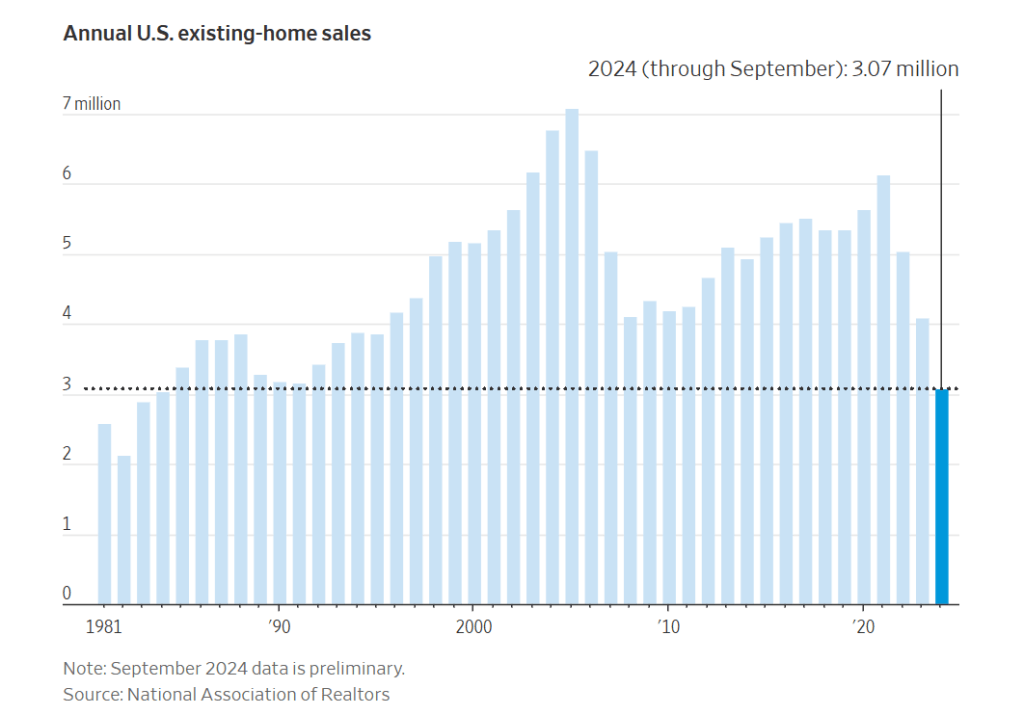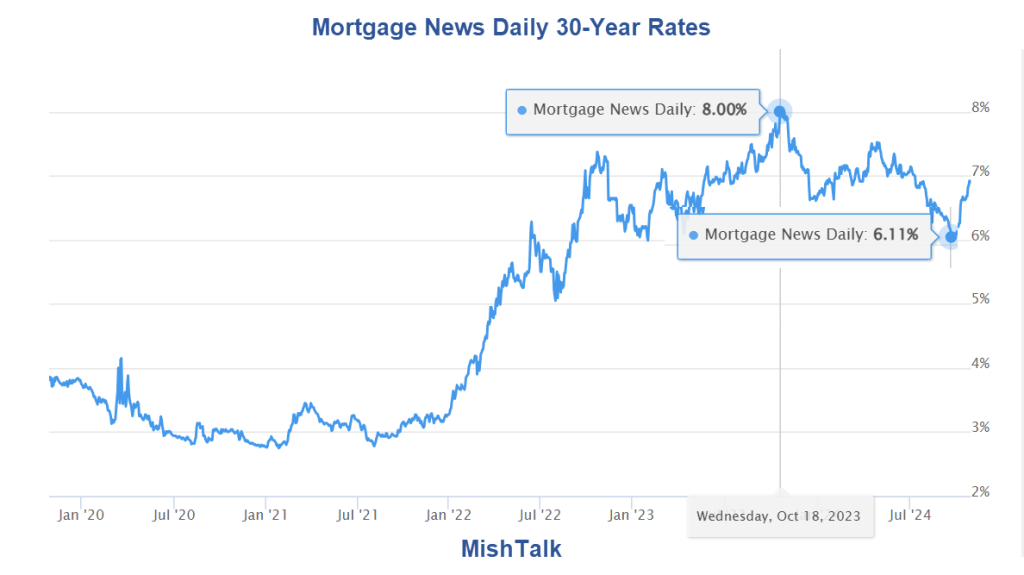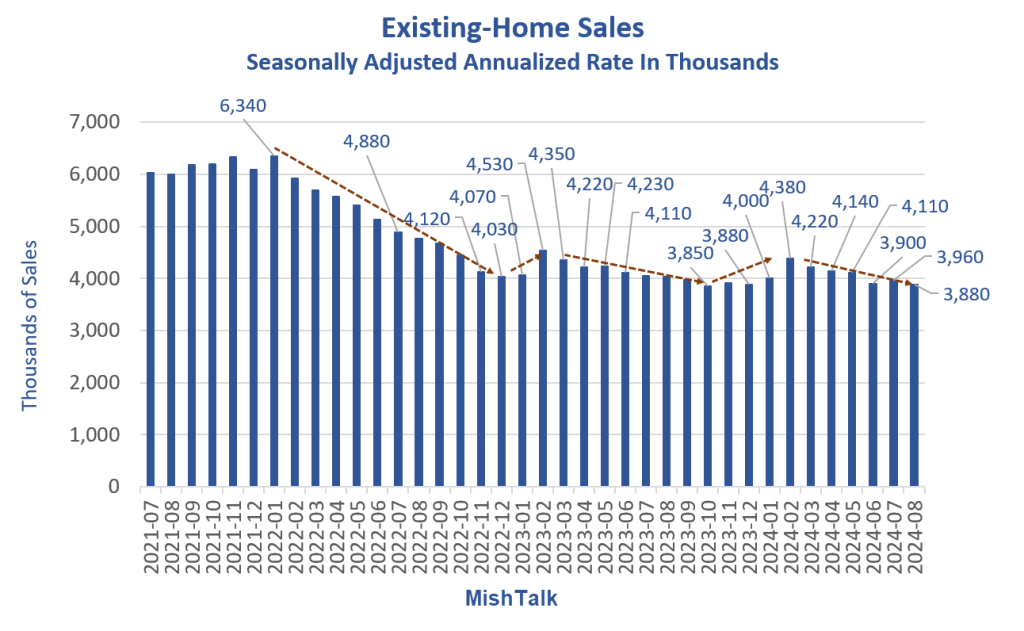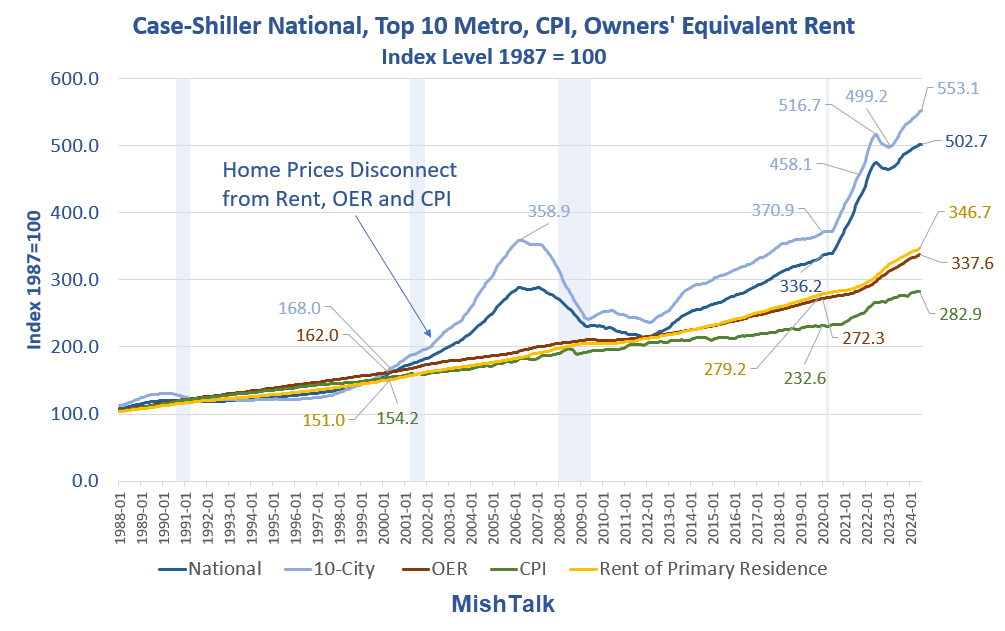The widespread theory (not in this corner) was the Fed would cut rates, mortgage rates would tumble, and that would stimulate existing home sales. What Happened?

The Housing Turnaround That Wasn’t
The Wall Street Journal reports This Year’s Housing Turnaround Ended Before It Started
The real-estate industry hoped 2024 would be a recovery year in which mortgage rates fell and home sales climbed. Mortgage rates dipped over the summer and hit a two-year low in September as they moved toward 6%.
But buyers continued to hold back. They have been spooked by expensive home prices and low inventory. Even at two-year lows, rates were still too high for many buyers, and now they have rebounded to their highest level in nearly three months.
Now, sales of existing homes are on track for their worst year since 1995 for the second year in a row, according to the National Association of Realtors. Even if this year’s sales slightly exceed last year’s level, they are still on track for the worst two-year period since the mid-90s, when the country’s population was considerably smaller.
“People are only moving if they have to,” said Nicole Dudley, a real-estate agent in the Phoenix area. “We’ll go a week without a showing, which is a long time compared to even last year.”
Powell’s Comment
“The real issue with housing is that we have had, and are on track to continue to have, not enough housing. And this is not something that the Fed can really fix,” said Powell.
I agree that the Fed cannot fix housing. But the Fed sure broke housing. Powell does not remotely understand the problem.
There is not a shortage of housing in the classic sense. The real problem is there is a shortage of housing people can afford to pay because the Fed broke the housing market with a nasty brew of bubble-blowing inflation.
Moving Target Trifecta

In a September, survey of more than 1,000 homeowners and renters, 70% said the highest mortgage rate they would accept was 5.49% or lower, according to John Burns Research & Consulting.
I don’t doubt that response at all. But it’s not just a matter of lower rates.
It’s a matter of lower rates, lower prices, and an economy on firm footing.
Mortgage rates fell from 8 percent to 6.11 percent. The impact on housing was nonexistent.
Existing-Home-Sales

There was a brief bounce in January of 2024. But there was one in January of 2023 and 2022 as well. I suspect something is amiss with Seasonal adjustments.
Regardless, mortgage rates continued to decline throughout 2024 but sales are where they were a year ago.
Median Prices
The National Association of Realtors notes the median existing-home sales price climbed 3.0% from September 2023 to $404,500, the 15th consecutive month of year-over-year price increases. All four U.S. regions registered price increases.
First-time buyers were responsible for 26% of sales in September – matching the all-time low from August 2024 and November 2021.
Median prices keep rising and that is for less, and less house.
Yet Another Record High for Case-Shiller Home Prices
The recently released Case-Shiller national and 10-city home price indexes hit new highs for July.

On September 28, I reported Yet Another Record High for Case-Shiller Home Prices
The pre-pandemic Case-Shiller national index was 370.9. Now it’s 553.1.
Home prices are up 49 percent in less than five years. And thanks to Fed QE wizardry, people could have and did refinance their mortgage at 3.0 percent or even less.
That put extra money, every month, into everyone who refinanced then. Extra money fueled inflation.
A $150,000 House in 1988 Now Costs $707,500 Thank You Fed
Using Case-Shiller data of repeat sales, on August 10, 2024, I noted A $150,000 House in 1988 Now Costs $707,500 Thank You Fed
This is a mess entirely of the Fed’s making. And it’s what happens when the Fed, and economists in general do not count home prices as inflation.
And Now?
Now the Fed says it cannot fix a problem it created. If only it would admit it created the problem.
And Lawrence Yun, the NAR chief economist cheerleader blames poor sales on the election.
For discussion, please see Head NAR Cheerleader Blames the Election for Poor Existing-Home Sales
Finally, clever readers will note I only discussed two of the three things holding back sales.
The three things were prices, mortgage, rates, and the economy. Let’s finish with the latter.
October 22, 2024: 20 Percent of Households Making Over $150,000 Live Paycheck to Paycheck
The Fed has grossly distorted the housing market and no fix is in sight.
October 23: Fed Beige Book Shows Only 3 of 12 Regions Growing, 3 Declining
The Fed Beige book shows a mostly steady economy in 6 of 12 regional reports. “Steady” is in context of the the worst Beige Book in years.
October 24: Continued Unemployment Claims Are the Highest Since November 13, 2021
Continued claims look bad. But they are only part of the picture. The complete picture suggests recession.
That makes three strikes. Prices don’t support more sales. Mortgage rates don’t support more sales. And the economy does not support more sales.
End the Fed
I believe I have made the case to end the Fed. Rather, the Fed made the case against itself.
This idea was a discussion focus on this blog and the Mises Institute in a series of recent posts.
Please see Fed “Playing With Fire” Take Two, Who Starts the Business Cycle? for a discussion of ideas and alternatives on ending or reigning in the Fed.